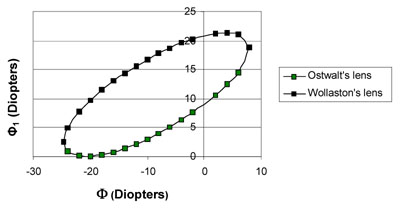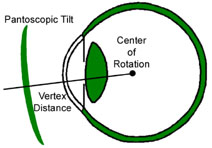Optipedia • SPIE Press books opened for your reference.
Spectacles: Single Vision
Excerpt from Field Guide to Visual and Ophthalmic Optics
Single vision spectacle lenses contain a single optical power and are typically composed of two spherical surfaces. The rear surface of the spectacle lens is usually placed about 14 mm from the cornea. This distance gives sufficient space to keep the eyelashes from brushing against the lens. The eye is mobile and moves about the center of rotation relative to the optical axis of the spectacle lens. Since the eye looks through different portions of the lens, off-axis aberrations become important in designing spectacle lenses. Astigmatism is the primary cause of degradation in image quality in eccentric viewing. Using a thin lens approximation, the required total lens power that eliminates astigmatism can be determined for a given front surface. The rear surface power is the difference between the total and front surface powers:

where
φ1 = the power anterior surface of the lens
Φ = total power of the lens
n = index of refraction of the lens
q' = spectacle lens to center of rotation distance (~27 mm).
The preceding equation describes Tscherning’s ellipse. The exact shape and position of the ellipse depends upon the index and the value of q'. The lower portion of the ellipse is called the Ostwalt branch and corresponds to flatter lenses. The upper portion is called the Wollaston branch and corresponds

Spectacle Lenses
While the Tscherning ellipse provides the shapes of the surfaces of a spectacle lens that minimizes astigmatism, the wearer’s anatomy must also be considered when designing a spectacle lens. The lens should not interfere with the eyelashes or touch the brow or cheek when properly aligned. The lens should also be cosmetically appealing, which of course is highly subjective. Typically, spectacle lenses follow the Ostwalt’s branch of the Tscherning ellipse since these lenses tend to have flatter curvatures and are more “attractive.”  To avoid contact with the brow and the cheek, pantoscopic tilt between 5 and 7 degrees is usually introduced. Simply tilting the spectacle lens would introduce off-axis aberrations when viewing through the lens, so pantoscopic tilt also requires that the lens be decentered such that the optical axis of the lens passes through the center of rotation of the eye. For each degree of tilt, the optical center of the lens needs to be shifted 0.5 mm. The center of rotation of the eye is roughly 13 mm behind the corneal vertex. The vertex distance is the distance between the corneal vertex and the back surface of the spectacle lens. A wearer’s prescription is usually obtained at a vertex distance of 12 to 14 mm. If the frames that hold the lens are designed for a different vertex distance, then the power of the spectacle lens needs to be adjusted. This procedure is known as vertex adjustment. If the required prescription Φ1 was measured at a vertex distance d1, then the new power
To avoid contact with the brow and the cheek, pantoscopic tilt between 5 and 7 degrees is usually introduced. Simply tilting the spectacle lens would introduce off-axis aberrations when viewing through the lens, so pantoscopic tilt also requires that the lens be decentered such that the optical axis of the lens passes through the center of rotation of the eye. For each degree of tilt, the optical center of the lens needs to be shifted 0.5 mm. The center of rotation of the eye is roughly 13 mm behind the corneal vertex. The vertex distance is the distance between the corneal vertex and the back surface of the spectacle lens. A wearer’s prescription is usually obtained at a vertex distance of 12 to 14 mm. If the frames that hold the lens are designed for a different vertex distance, then the power of the spectacle lens needs to be adjusted. This procedure is known as vertex adjustment. If the required prescription Φ1 was measured at a vertex distance d1, then the new power
Φ2 at a vertex distance d2 is

Typically, the difference in power is small unless the spectacle lenses are stronger than ±7.00 diopters. Vertex adjustment is also important in prescribing contact lenses from a spectacle prescription. In this case, d2 = 0.
J. Schwiegerling, Field Guide to Visual and Ophthalmic Optics, SPIE Press, Bellingham, WA (2004).
View SPIE terms of use.

